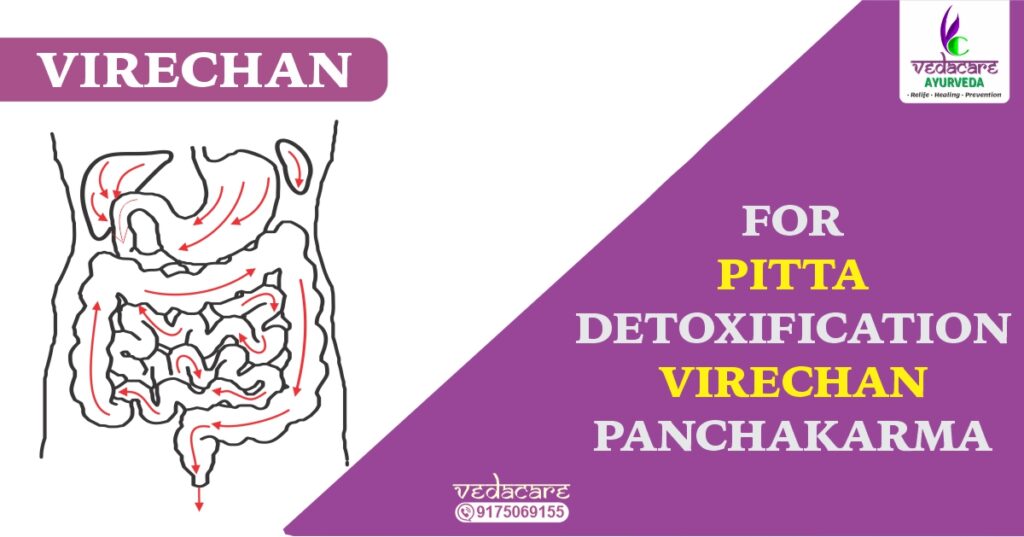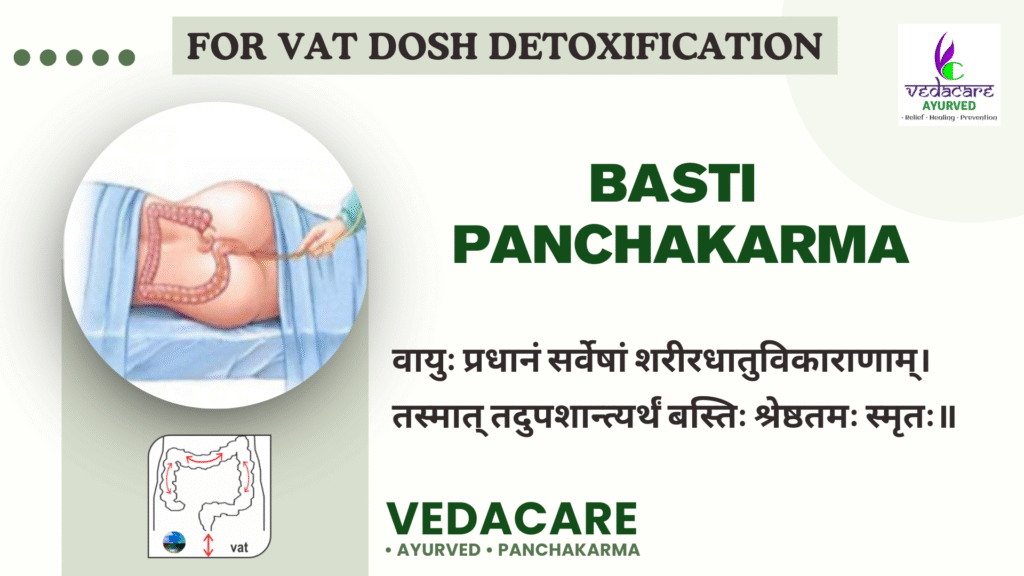PANCHAKARMA
VIRECHAN – विरेचन
Introduction to Virechana: Ayurvedic Purgation Therapy
In Ayurveda, Virechana (therapeutic purgation) is a specialized detoxification process within the Panchakarma framework, aimed at cleansing the body and eliminating excess Pitta dosha. It also serves as an effective remedy for Vata imbalances. By purging toxins (ama) through controlled bowel movements, Virechana restores balance, enhances digestion, and prevents disease recurrence.
As the Charaka Samhita (Sutra Sthana 16) states:
यत्र तु संशोधनाः शुद्धाः न तेषु पुनरुद्भवः|
diseases purified through cleansing therapies like Virechana do not recur.
This therapy is particularly beneficial for conditions like skin disorders, liver diseases, and chronic fevers, making it a go-to solution for those seeking natural healing. Under expert supervision, Virechana’s structured process, including preparation, purgation, and post-therapy care, ensures safe and effective detoxification.
What Is Virechana?
Virechana is the second among the five fundamental therapies of Panchakarma in Ayurveda. It is a classical purgation therapy used to eliminate excess Pitta dosha from the body through the lower gastrointestinal tract. This gentle yet powerful detoxification method is best suited for diseases associated with Pitta imbalance, and is also effective for certain Vata-related disorders.
Virechana involves the use of safe, herbal purgatives to cleanse the intestines. It is always preceded by preparatory therapies – Snehana (oleation) and Swedana (fomentation) – which help to mobilize toxins and bring the vitiated doshas into the gastrointestinal tract for easy elimination.
विरेचनं पित्तहरं मारुतस्य च शस्यते।
Virechana eliminates Pitta and is beneficial for Vata disorders.
When Is the Best Time for Virechana Panchakarma?
The ideal season for Virechana Panchakarma is Sharad Ritu (Autumn), when Pitta dosha naturally accumulates and needs to be expelled for maintaining balance.
Benefits of Virechana Therapy
Virechana offers a wide range of health benefits, addressing both physical and systemic imbalances. By targeting the liver, intestines, and blood, it promotes holistic wellness.
- Lightness in the Body: Eliminates heaviness caused by toxin accumulation.
- Improved Appetite: Enhances digestive fire (agni), boosting metabolism.
- Reduced Disease Recurrence: Prevents chronic conditions by addressing their root cause.
- Enhanced Immunity: Strengthens the body’s natural defenses.
- Weight Management: Supports healthy weight loss by clearing excess Pitta and toxins.
- Lowered Cholesterol and Triglycerides: Improves lipid profiles naturally.
- Skin Health: Reduces conditions like psoriasis, eczema, and dermatitis.
- Toxin Removal: Purifies blood and eliminates harmful substances.
विरेचनं पित्तप्रधानं दोषहरणम् |
Virechana is the primary therapy for expelling Pitta-related toxins, ensuring systemic balance.

Indications for Virechana Therapy
Virechana is recommended for a variety of acute and chronic conditions, particularly those linked to Pitta and Vata imbalances. Clinical indications include:
Skin Disorders
- Psoriasis, eczema, dermatitis, urticaria
- Allergic skin conditions and obstinate skin diseases
- Pigmented spots on face and pigmentation issues
- Acute bacterial infection of the skin and mucous membrane
Hepato-Biliary System
- Jaundice and hepatitis
- Gallbladder stone (Cholecystitis)
- Liver enlargement and splenic enlargement due to different causes
Gastrointestinal Disorders
- Acid peptic disorders with repeated attacks of burning & acidity
- Indigestion, chronic constipation, and tastelessness
- Disease characterized by both vomiting and diarrhea
- Abnormal stagnation of food in the gastrointestinal tract
- Diseases related to abdomen characterized by abdominal pain and mass
- Hemorrhoids and fistula-in-ano
- Worm infestations
Respiratory System
- Bronchial asthma and respiratory allergies
- Nasal discharge
Neurological Conditions
- Headaches
- Migraines
- Paralysis
Endocrine and Metabolic Disorders
- Diabetes mellitus
- Thyroid swelling
- Anemia and chlorosis
Urinary System
- Diseases characterized by polyuria and abnormal character of urine
- Reduction in urine output
Gynecological Conditions
- Menstrual irregularities
- Infertility
- Low Semen count
Cardiovascular System
- Disorders of the heart
Hematological Disorders
- Diseases characterized by tendency of spontaneous bleeding
- Bleeding from nose (epistaxis)
- Anemia
Infectious and Febrile Conditions
- Chronic fevers and recurrent febrile illnesses
- Slow poisoning
Oncological Conditions
- Malignant tumors
- Cystic swellings
Eye Conditions
- Burning eyes and mouth
- Watering of the eyes (epiphora)
Mental health
- Unmada (insanity) and Apasmara (epilepsy) with Pitta vitiation
Preventive and seasonal therapy
- Seasonal detoxification in Sharad ritu (autumn) to balance Pitta in healthy individuals
- Preparation for Rasayana (rejuvenation) therapies

Types of Virechana
- Snigdha Virechana (Oleation-based) – Uses medicated oils (e.g., Castor oil + Haritaki) for Pitta-Vata disorders.
- Ruksha Virechana (Dry Purgation) – Uses drying herbs (e.g., Trivrit Leha) for Pitta-Kapha conditions.
Virechana Procedure:
The Virechana process is meticulously structured to ensure safety and efficacy. It comprises three stages: Purvakarma (preparation), Pradhana Karma (main procedure), and Paschat Karma (post-procedure).
1. Purvakarma (Pre-Procedure Preparation)
This phase prepares the body for detoxification through the following steps:
- Patient Examination (Rogi Pariksha): The practitioner assesses the patient’s physical strength, dosha imbalances, Prakriti and Vikriti, Strength of digestion (Agni), Age, strength, season, and chronicity of disease and suitability for Virechana. Contraindications are ruled out to ensure safety.
- Dipana-Pachana Chikitsa: For 1–2 weeks, digestive medicines are administered to optimize gastrointestinal function and break down toxins (ama).
- Snehapana (Internal Oleation): Based on the individual’s constitution (prakriti) and condition (vyadhi), Digestive capacity, Nature of disease, Medicated ghee or oil is consumed for 5–7 days, based on the patient’s constitution and condition. The dosage (500–800 ml) is tailored to mobilize toxins.
- Abhyanga and Swedana: On the 8th day, external oil massage (abhyanga) and steam therapy (swedana) are performed to further loosen toxins and direct them to the digestive tract.
2. Pradhana Karma (Main Procedure)
On the 9th day, Virechana is performed, typically in the morning on an empty stomach for optimal results. The patient is given a customized purgative medicine to induce 10–30 controlled bowel movements (loose motions), depending on the degree of purification needed (hina, madhyama, or ati yoga). The process expels Pitta, Vata, and toxins, cleansing the lower digestive tract.
3. Paschat Karma (Post-Procedure Care)
Post-Virechana, the digestive fire (agni) is weak, requiring a gradual dietary regimen called Samsarjana Krama.to restore digestive strength. This 3–7-day protocol restores digestion through light, digestible foods, transitioning from liquids to solids. Virechana can cause fatigue, so resting for 2 days is recommended. The diet is planned to rekindle the digestive fire (agni) and restore normal digestion.
Virechana Pre and Post Diet:
Diet plays a critical role in Virechana’s success. Specific protocols are followed before and after the therapy to support detoxification and recovery.
Pre-Virechana Diet
From the start of Snehapana to the day before Virechana (days 1–8).
- Consume warm, unctuous, and liquid foods like meat soup, rice, and sour fruits.
- Avoid Kapha-aggravating foods (e.g., dairy, cold foods).
- On the day of Virechana, no food is allowed until the purgative medicine is administered.
Post-Virechana Diet
Samsarjana Krama
- Initial Phase Post-Virechana: With the digestive fire at its weakest, only liquid-based foods are suitable. Thin, easily digestible gruels, such as those prepared from rice or barley, are recommended to avoid straining the digestive system.
- Progressive Dietary Shift: As the digestive capacity strengthens over time, the diet transitions gradually from liquids to semi-solid foods, and eventually to regular solid meals. This phased approach prevents overburdening the digestive system.
- Objective: The gradual dietary progression ensures complete recovery of digestive strength, promoting overall healing and balance post-therapy.
| Day | Mealtime | Pravara (Strong Purification) | Madhyama (Medium Purification) | Avara (Mild Purification) |
| Day 1 | Morning | Manda (Thin Rice Water) | Manda (Thin Rice Water) | Manda (Thin Rice Water) |
| Noon | Manda (Thin Rice Water) | Manda (Thin Rice Water) | Manda (Thin Rice Water) | |
| Evening | Manda (Thin Rice Water) | Peya (Slightly Thicker Rice Water) | Peya (Slightly Thicker Rice Water) | |
| Day 2 | Morning | Peya (Slightly Thicker Rice Water) | Peya (Slightly Thicker Rice Water) | Vilepi (Thick Rice Gruel) |
| Noon | Peya (Slightly Thicker Rice Water) | Vilepi (Thick Rice Gruel) | Vilepi (Thick Rice Gruel) | |
| Evening | Peya (Slightly Thicker Rice Water) | Vilepi (Thick Rice Gruel) | Odana with Yusha (Rice with Thin Pulse Soup) | |
| Day 3 | Morning | Vilepi (Thick Rice Gruel) | Odana with Yusha (Rice with Thin Pulse Soup) | Odana with Yusha (Rice with Thin Pulse Soup) |
| Noon | Vilepi (Thick Rice Gruel) | Odana with Yusha (Rice with Thin Pulse Soup) | Odana with Mamsa Rasa (Rice with Meat Soup) | |
| Evening | Vilepi (Thick Rice Gruel) | Odana with Mamsa Rasa (Rice with Meat Soup) | Normal Diet (Sarvagrasabhojana) | |
| Day 4 | Morning | Odana with Yusha (Rice with Thin Pulse Soup) | Odana with Mamsa Rasa (Rice with Meat Soup) | – |
| Noon | Odana with Yusha (Rice with Thin Pulse Soup) | Normal Diet (Sarvagrasabhojana) | – | |
| Evening | Odana with Yusha (Rice with Thin Pulse Soup) | Normal Diet (Sarvagrasabhojana) | – | |
| Day 5 | Morning | Odana with Mamsa Rasa (Rice with Meat Soup) | Normal Diet (Sarvagrasabhojana) | – |
| Noon | Odana with Mamsa Rasa (Rice with Meat Soup) | – | – | |
| Evening | Odana with Mamsa Rasa (Rice with Meat Soup) | – | – | |
| Day 6 | Morning | Odana with Vegetables and Ghee | – | – |
| Noon | Odana with Vegetables and Ghee | – | – | |
| Evening | Odana with Vegetables and Ghee | – | – | |
| Day 7 | Morning | Normal Diet (Sarvagrasabhojana) | – | – |
| Noon | Normal Diet (Sarvagrasabhojana) | – | – | |
| Evening | Normal Diet (Sarvagrasabhojana) | – | – |
विरेचनं पित्तहरं प्रशस्तं
दूष्येषु रक्ते हि विशेषतोक्तम्।
विषं च सन्दूष्य च मूत्रमेव
रक्तं च दोषं पित्तरक्तजं च॥
— अ.हृ.सुत्रस्थानVirechana is specifically beneficial for eliminating Pitta and Rakta-related diseases, including toxins present in blood and urine.
Contraindications for Virechana
While Virechana is highly beneficial, it is not suitable for everyone. Contraindications include:
- Weak or emaciated individuals
- Pregnant or postpartum women
- Patients with severe dehydration or electrolyte imbalances
- Those with acute infections or fever
A thorough assessment by an Ayurvedic practitioner is essential to determine eligibility.
How Virechana Works
Virechana’s efficacy lies in its ability to target the liver and intestines, key sites of Pitta accumulation. By purging toxins, it:
- Reduces inflammation linked to Pitta disorders.
- Clears blood impurities, improving skin and systemic health.
- Balances lipid metabolism, aiding cholesterol management.
- Enhances agni, preventing digestive disorders.
Modern research supports Virechana’s role in managing conditions like psoriasis, hyperlipidemia, and chronic liver diseases, aligning with Ayurveda’s holistic principles.
Virechana in Combination with Vamana
When Virechana follows Vamana (therapeutic vomiting), slight modifications are made. After Vamana’s post-procedure diet (Samsarjana Krama), a shorter Snehapana (3–5 days) may be prescribed before Virechana. This combination enhances detoxification, addressing both Kapha and Pitta imbalances.
Conclusion
FAQ
1. Is Virechana safe?
Yes, when conducted by a qualified Ayurvedic doctor, it is completely safe, natural, and free of side effects.
2. Can Virechana help with weight loss?
Yes, Virechana supports weight management by clearing toxins and improving metabolism, but it should be paired with a balanced diet and lifestyle
3. What is Virechana in Ayurveda?
Virechana is a Panchakarma therapy involving controlled purgation to eliminate Pitta-related toxins from the lower digestive tract, promoting detoxification and balance.
4. How often should Virechana be done?
Once a year is ideal, especially during autumn, or as per the advice of a certified Ayurveda practitioner
5. Can I do Virechana at home?
No, it should be done only under medical supervision to avoid complications like dehydration or excessive purging.
6. Is Virechana painful or uncomfortable?
While purgation causes loose motions, it is not painful it is gentle & controlled. Discomfort is minimal and subsides within hours.
7. Can Virechana reduce weight?
Yes, it helps manage obesity, PCOD, thyroid, and lipid disorders by improving liver function and digestion.
8. How does Virechana differ from Vamana?
Vamana is for Kaph and done through vomiting; Virechana is for Pitta and done through purgation.
9. How long does Virechana take?
The full course including preparation, therapy, and post-therapy care takes 10 to 18 days.
10. Can Virechana help with skin problems?
Absolutely. Virechana is the best therapy to detoxify the blood and liver, by purifying blood and reducing Pitta, Virechana alleviates conditions like psoriasis, eczema, acne and dermatitis and other chronic skin conditions addressing their root causes.
11. Is Virechana safe for everyone?
No, it’s contraindicated for pregnant women, weak individuals. A practitioner’s evaluation is essential.
12. How long is the Virechana diet after therapy?
The post-therapy diet (Samsarjana Krama) lasts 5–7 days, depending on the degree of purification, gradually reintroducing solid foods.
13. Can Virechana cure liver diseases?
Virechana supports liver health by detoxifying the organ and balancing Pitta, but chronic conditions require ongoing Ayurvedic management.
14. What foods should I avoid before Virechana?
Avoid Kapha-aggravating foods like dairy, cold items, and heavy meals. Stick to warm, unctuous foods like soups and rice.
15. How Often Should One Do Virechana?
Once a year for preventive detox or as prescribed for chronic conditions
16. How often should Virechana be done?
Virechana is typically performed seasonally (e.g., autumn) or as needed, based on dosha imbalances and practitioner guidance.
17. Is Virechana Safe for Weight Loss?
Yes, it removes metabolic toxins, aiding sustainable weight loss
18. Does Virechana Cause Weakness?
Mild fatigue may occur, but Samsarjana diet restores energy
19. Can Diabetics Undergo Virechana?
Yes, it helps regulate blood sugar but must be supervised
20. Can Virechana Cure Psoriasis?
Yes, it purifies blood & skin, reducing flare-ups. Before doing virechan if Vaman panchakarma is done it helps more to cure
Virechana is a transformative Ayurvedic therapy that detoxifies the body, balances Pitta and Vata, and prevents chronic diseases. With its structured preparation, purgation, and post-therapy care, it offers a safe, effective path to holistic wellness.
By integrating Virechana into your health regimen under expert supervision, you can achieve lasting vitality, improved immunity, and relief from conditions like skin disorders, liver issues, and digestive imbalances. For more insights, always consult a qualified Ayurvedic practitioner.
Along with Virechana therapy Raktamokshan, Vaman, Basti, Shirodhara treatments are useful in fastening the disease recovery.



